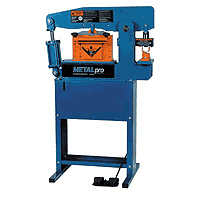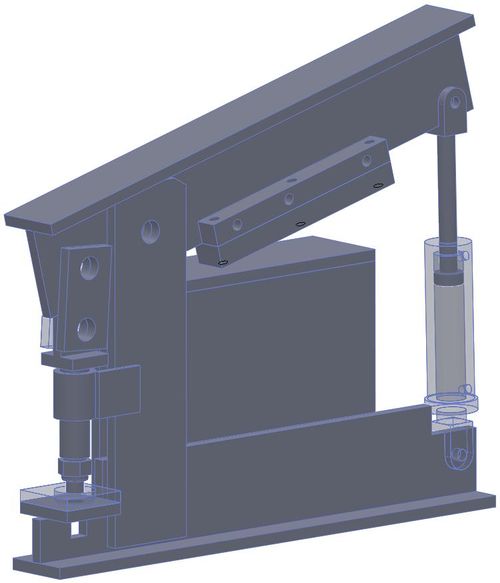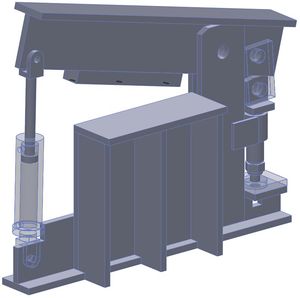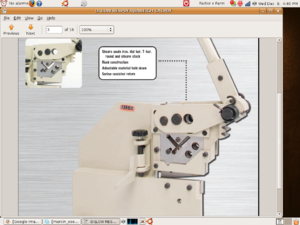Ironworker/Research Development
| Ironworker | ||
|---|---|---|
| Home | Research & Development | Bill of Materials | Manufacturing Instructions | User's Manual | User Reviews | 
| |
Overview
Brianna Kufa was (as of 3/17/12) developing an ironworker which imitates a 50T Piranha, but with increased punching and shearing capacities. See her blog for the latest updates on progress.
Here are some calculations made my Mischa John for the punch stripper element. The analysis proved the current design on that element was insufficient. We are now working on another one which will provide enough resistance.
The Scotsman ironworker provided as an example was validated on A36 steel, which has a UTS of 400MPa.[1] That works out to about 58kpsi.[2] So the amount of force necessary to shear 12 square inches (1 by 12) of a material with 58kpsi UTS should be 487,200 pounds or 245 short tons.
I believe the grabCAD competition specified a 5" hydraulic cylinder. Assuming it's operating at 2500psi that should give it around 25 short tons (49k pounds). So, to get a 120T ironworker you'd need at least 5X mechanical advantage. And to get 250 short tons at the shear I guess you'd need 10X mechanical advantage. (10X advantage means the cylinder will travel 10" while cutting the 1" workpiece -- it might be worthwhile to increase the cylinder diameter.)
Also, you'd want the motion to be such that the hydraulic cylinder is extending, because that direction will be stronger than pulling.
Metalpro's 45ton ironworker looks about as simple as you can get. It's got about 25tons at the flat shear. So, if you replaced the hydraulic cylinder with a linkage down to a lever underneath the table, and had a longer cylinder under the table, you could get 5-10X mechanical advantage and increase the tonnage at the shear until it could cut through 1x12" plate. Here is a good overview of how it functions.
Articles about shear design here and here.
Concepts
- 120 ton (108 metric tons) for up to 1.5" holes in 1" metal
- Can be based on the existing Holepuncher Prototype I design
- Shear for 8-12" of 1" steel
- Angle cutter for up to 6x6 angle
- DIY shear blade - made from case hardening of mild steel, at $40 in materials
- what is trade-off of DIY material against the S-7 class of steel usually used for commercial shear blades?
- May involve Induction Furnace for hardening
From SMJ Tsakok
Adding a metal shear element to Ironworker Prototype I:
Solidworks model:
File:Holepunhersolidwks.tar.gz
Research
Other Research
Small (<50 ton) ironworker from Northern Tool:

- http://www.docstoc.com/docs/16819551/The-Marvels-of-Hydraulic-Ironworker-Bending-Machine-and-Punching-Machine
- http://www.articlelarder.co.cc/?p=292
- this has the original article by Issac Wang
The Marvels of Hydraulic Ironworker, Bending Machine and Punching Machine
Ironworker machines can shear, punch holes and notch In steel plates. These machines generate force using hydraulic systems or mechanical leverage. Modern systems make use of hydraulic rams that are powered by heavy alternating current electric motors.
Incidentally, the hydraulic ironworker is an engineering marvel. It is not to be mistaken for a single machine. It is the amalgamation of 5 machines clubbed into a single engineering wonder. It comprises of a punching machine, a plate shear, a section shear, a punch and shear machine and a coper-notcher.
Irrespective of the size of any fabricator’s workshop, an ironworker forms the backbone. It is a versatile machine. It is an important tool in a metal workers shop. Very often, a cheap hydraulic ironworker is constructed. This leads to erosion of the die and the punch on the front rims. Higher quality machines are a must because they ensure durability and productivity. It ensures tooling longevity and helps you capitalize on the machine's total tonnage.
Selecting a right hydraulic ironworker from an OEM/ODM manufacturer for your application can be taxing job. There are some key pointers like versatility and safety features that you need to keep In mind. Consider its quality and capacity as well. The material thickness is another important aspect to be considered. It indicates whether you should use a trim press or an ironworker. An ironworker is capable of punching plate up to 1 inch. Usually, trim presses are used on sheet material 1/4 in. and thinner. ironworker machines are opted for shorter production runs and those applications for which tolerances are not too critical.
Ironworker machines are usually rated by tonnage at the punch station. it is essential to ascertain the maximum material thickness so that you can establish the tonnage range required for your punching application. You need to also examine the product and the steel rack that you need to fabricate. Make sure you determine the maximum hole diameter that needs to be punched. Don’t forget to focus on the maximum width and thickness of the angle, channel and rod to be bent or sheared.
You can also look out for a bending machine and options like larger press brake bending attachments. These machines are capable of using a larger variety of tooling as compared to those with built-in stations, however, you need time to switch from one operation to the other.
when choosing an ironworker from an OEM_ODM manufacturer or exporter, 'safety' should be your top most concern. Addressing safety issues is extremely Important. While there are many OEM/ODM manufacturers in the business, especially In Taiwan, you an make sure that you select the hydraulic ironworker and bending machine that meets ANSI B 11-5 standards.
It is necessary no examine the guarding as well. Make sure it is adjustable and it complies with the ANSI standard. Be careful of hydraulic ironworker and punching machine with automatic urethane hold-downs The Blade is dangerous and it can hurt you in the process. ‘Adjustable Stroke Control’ another feature to look out for. This ensures safety as well as productivity. It minimizes machine movements and reduces the number of pinch points. It also increases your productions and strokes per minute. It is a crucial factor in bending and special tool applications. The upstroke and downstroke need to be adjusted.
Thanks to ironworkers, punching holes of different sizes and shapes has never been so easy. From cutting to notching, from shearing to bending bars, you can do it all!
Examples
http://www.edwardsironworkers.com/60ton.html
Hole Punch Dies (see [Hole Punch Dies])
Companies
- Edwards - [3]
- Cleveland Punch and Die - [4]
- Metalpro - cheap ironworkers - http://www.metalprocorp.com/viewProduct.jsp?id=24
- Fabtec - metal workers and parts - [5]
Standard Metal Punch Units
- Complete unit? [6] Yes, but only sheet metal.
Hand Punch
Parts
Operating Tips
Metal Punch Fabrication Strategy
Using s punch stem and coupling nut [13], combined with a punch and die standard [14] - we are ready to put together a metal punching assembly, provided that
See Also
References


